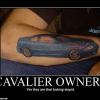Itbs Are The New Turbo
 cbstdscott
11 Mar 2013
cbstdscott
11 Mar 2013
This will cost another $50.
 cbstdscott
15 Mar 2013
cbstdscott
15 Mar 2013
Progress is slow largely because I am clueless. But once my journey is complete I will post pictures and the most direct route to achieving ITBs.
Scott
 regularguy
19 Mar 2013
regularguy
19 Mar 2013
im sorry if i discouraged you even a little, i just want you to know what youre going up against. fight the good fight, im rooting for you and ill try my best to help out as much as possible. if you are still looking for another si manifold i do have an 86 crx si for parts that might help.
as for runner spacing, you should be able to washer the crap out of most motorcycle itbs to hopefully get spacing close. you will have to address linkage and other mechanical connections but that might be easier than reshaping and fudging the manifold itself. also, silicone hoses do have a good amount of flex that might allow some tolerance. whatever you do, find a way to brace the itbs to the engine- i had a friend that had a set of motorcycle itbs running decently well all the way until they fell off the car, haha. it was a second gen crx so there were a lot more options but the principle was the same.
 cbstdscott
19 Mar 2013
cbstdscott
19 Mar 2013
Actually, I am a bit disgusted right now. The engineering techniques to make everything line up is tougher than I had originally thought. When I get the chance, I am going to have to spend some time with a hand file.
I am trying to avoid dismantling the ITBs from the motorcycle into separate units, it becomes a big chore to make them open and close in unison when you do that. They are happiest when they are bound together as the factory intended.
If this project does not pan out, I can always fall back on building a single TB manifold which is now looking to be an easier goal to accomplish.
Scott
 cbstdscott
15 Apr 2013
cbstdscott
15 Apr 2013
Long and careful thought, combined with great comments from people who know a lot more than I do (that would be about everybody in the world) I have come to realize that the ITBs are not going to give me the range of performance that I am looking for in an autocross/street car.
But still the quest for a better breathing intake goes on! So I am back to the single TB design.
The ideal would be to create a plenum that incorporates velocity stacks for each runner. I am now exploring how to make that plenum line up with the section of the stock intake manifold that bolts to the head so I can use the stock injector ports and fuel rail.
The journey of discovery continues!
 zakats
16 Apr 2013
zakats
16 Apr 2013
I'm not sure that you'd get all of your desired performance, but, have you considered a later model D series IM? I recall some discussion about which of them would work and to what benefit.
 cbstdscott
16 Apr 2013
cbstdscott
16 Apr 2013
I have witnessed how much flow improvement is possible with a velocity stack at tbe inlet to a CAI and my research indicates that velocity stacks at each runner makes a huge improvement.
I have the raw materiels at hand. What I need is fabrication help.
Scott
 zakats
18 Apr 2013
zakats
18 Apr 2013
Ah.. I figure you need to be willing to spend a lot on this project or have a lot of time, skill, and equipment to pull that off.
I'd like to see that done also... there are some really cool manifold build threads floating around the net on other forums.
 regularguy
19 Apr 2013
regularguy
19 Apr 2013
http://www.k20a.org/...ead.php?t=46798
post number 3 is interesting and a good point. i doubt that the stock ew manifold lower half lacks the length necessary for optimum performance. i agree that a set of stacks sticking up off the plenum floor is cool but seems like more work than progress. i wish the manifold didnt have that crazy loop leading to the head, it would help out high rpm performance. i would try to maximize plenum volume as there doesnt seem to be a lot of space to work with anyway.
as for the original itb ordeal, would it be possible to cut the manifold really close to the head side flange to accommodate the pipes welded on? i envision a cut that would allow the injectors to be set into the manifold at the original angle and have the studs for mounting the fuel rail fabricated with the pipes being welded onto the manifold flange... either that or by using the motorcycle injectors (hopefully sized large enough) instead of the original honda ones. that would give you some of the extra atomization from the longer distance the fuel travels in the runner like with a carb. it would be a pipe dream but having primary injectors down low with shower injectors past the itb horns would be exponentially cooler. i digress however, as i have yet to build an itb car but want to despite the added headaches it entails.
 Splitty456
21 Apr 2013
Splitty456
21 Apr 2013
That is a very god idea with the injectors... you could even have an RPM operated switch to switch between each rail. the further ones would operate in the lower RPM range (below 4000 say) and the standard ones above ![]() swirl on the back of the valves would help with atomisation even further
swirl on the back of the valves would help with atomisation even further ![]()


